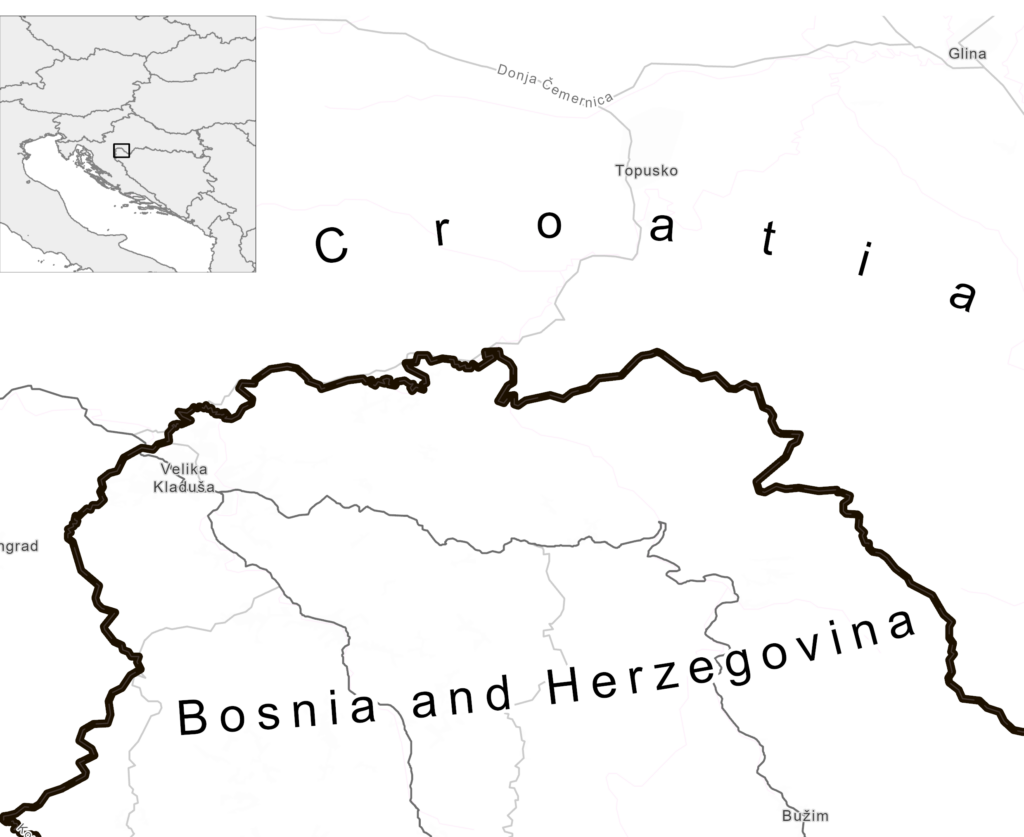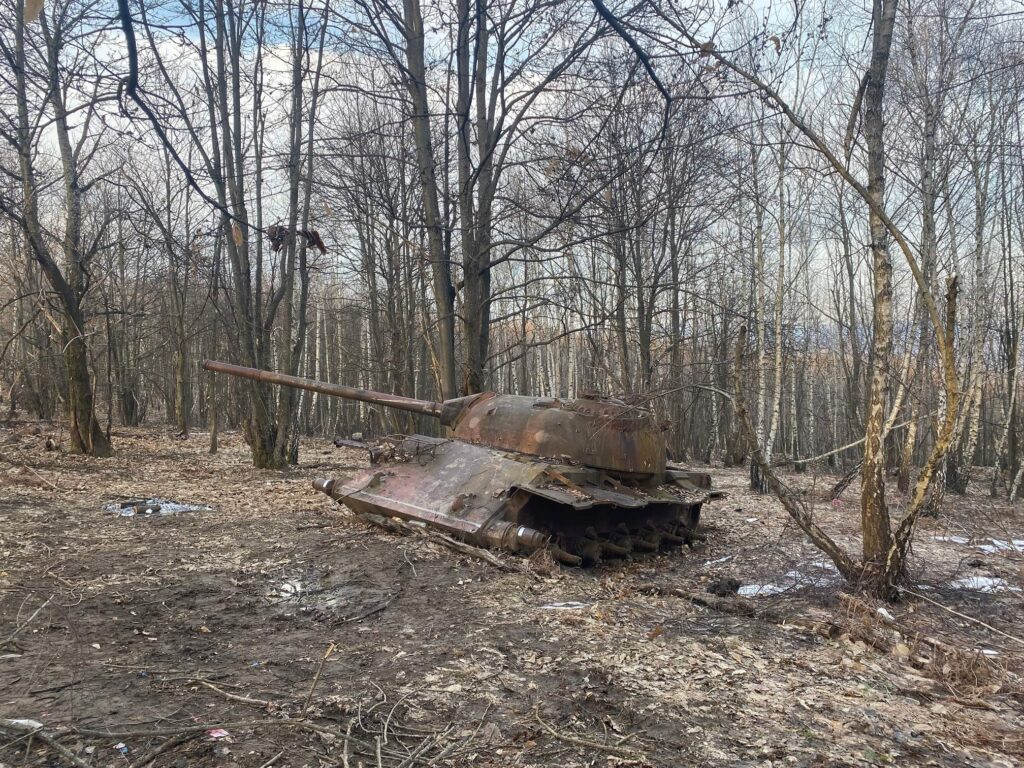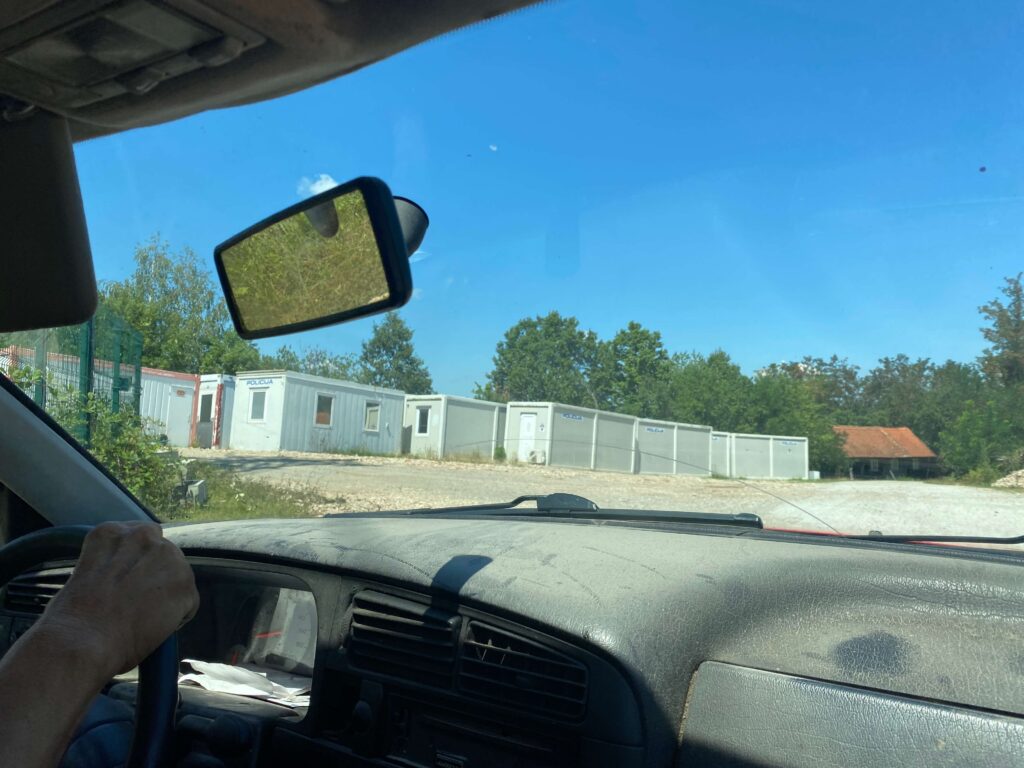Emptiness as a border
DOI: 10.60650/EMPTINESS-Z2GR-G053
Riding through the empty woodland
Bumping along in his old Volkswagen, Nikola effortlessly navigated the rugged paths along the abandoned, hilly border area between Croatia and Bosnia and Herzegovina (hereafter Bosnia). This area is rarely traversed nowadays by anyone other than a few remaining locals. As we drove, I looked out at the dense and difficult-to-navigate woodland that forms a border between two worlds. One is the European Union (EU) and Schengen area on the Croatian side, and the other is Bosnia on the other side. Wires, empty plastic bottles, bags, tools, and dust gathered around our feet in his car. It was suffocatingly hot, and the car’s engine noise made it hard to maintain a conversation. Nikola insisted on keeping the windows closed to keep out the dust from the unpaved roads despite his car itself needing a wash.
The area we traversed used to be lively and populated with several villages spanning from one side of the border to the other. However, on this journey we passed many ruined houses and abandoned cars, all overrun by wilderness. Nikola’s voice broke through the engine noise, narrating stories about these ruins and their previous owners. With a mournful tone he concluded: “They [the Croatian army] destroyed the village. It’s gone. Dead! No children will be born here again”.
It was summer 2022 when I sought Nikola’s help. A local shepherd in his late 60s living on the Croatian side of the border, I asked him to guide me through this woodland. Nikola knows the land better than anyone. He grew up in the area and kept his own sheep in the surrounding woods, regularly crossing the border back and forth. This woodland was, and still is, his home despite being “dead” to him. Every day Nikola navigates not only these dense woods but also the entangled temporalities of a land marked by periods of destruction, desertion, and turmoil. This section of land serves multiple roles: for Nikola, it’s home; for the border guards, it’s a territory needing security; and for the migrants passing through, it is a perilous forest. Hence, this area is marked by overlapping interpretations.
Within the complex layers of meaning attributed to this land, there appears the concept of ’emptiness’. In this context, emptiness stands alone as a core driver of the nuanced interpretations of this land. My research sought to understand how the border is sustained and influenced by current migratory flows, where emptiness is a fundamental feature. How can such a space, characterized by dynamic flows of migration and extensive periods of conflict, shape our understanding of temporal orientations and emptiness in borderlands?

Echoes of history
The map above (Fig 1) captures an area that has had many identities and meanings to different groups. Its historical and local name is Krajina. Krajina has held significance for many centuries, becoming a point of contention in the clashing interests of three major powers: the Habsburg Empire, Venetian Republic, and Ottoman Empire. Despite its significance, the area has been chronically poor and underdeveloped, an area where people tend to leave rather than arrive.
Krajina, also known as the ‘Military Frontier’, was an explicitly demarcated part of the Habsburg Empire. At the time, the region was sparsely inhabited by peasants allocated by the Empire to live there. The settlement was coordinated with the aim of forming a protective barrier against potential Ottoman invasions, and in return, the peasants were granted specific privileges such as owning the land.
During World War II, Krajina became a stronghold of vehement opposition to the fascist regime, and hosted one of Yugoslavia’s most ethnically varied Partisan groups. Many monuments to the victims of fascism built by the Yugoslav state remain, leaving evidence of the partisan movement. During the Yugoslav era (1945-91), the land around the border was mostly inhabited by peasants, livestock herders, many of whom were descendants of the Habsburg settlers. The area remained poor.
At the end of the 1970s, it was an infamous local businessman Fikret Abdić who brought the area to life. He built the famous food factory Agrokomerc which sustained the local community and provided jobs. However, even in the Yugoslav era, younger generations had begun leaving Krajina to seek better work opportunities in the bigger cities, hoping to achieve a better life, encouraged by ideas of progress and modernization. Then Yugoslavia fell apart, and the wars in Croatia (1991-95) and Bosnia (1992-95) broke out. Throughout this period, this land remained a point of contention. The area where Nikola lives, known as Kordun to those on the Croatian side, is now home only to a few elderly, isolated residents. As Nikola stated during our drive, the land feels dead, haunted by the echoes of a difficult past.

The war and its aftermath
The wars in the 1990s resulted in the fatal destruction of the area’s existing livelihoods. Following Croatia’s declaration of independence from Yugoslavia in 1991, the villages on the Croatian side of the border became part of the Republic of Srpska Krajina (RSK). A self-declared Serb entity in Croatia during 1991-95, the RSK was not recognized internationally. In 1995, the Croatian army launched Operation Storm, a major offensive that led to the recapture of these RSK-held territories; it brutally ended the RSK and led to a mass exodus of Serbian civilians. The sudden emptiness, a direct result of conflict and expulsion, meant that many villages on both sides of the border have remained abandoned ever since – one of which is Nikola’s.

War is not the only factor contributing to prolonged abandonment here. The repercussions of the conflict indeed significantly impacted the region, leaving a lingering sense of emptiness in these borderlands among the people who chose to return or remain there after the war. Unresolved repercussions include the return of refugees, ethnic tensions, property ownership, and reconciliations. Beyond the immediate impact of war, the political and economic landscape of its aftermath significantly further enhanced the sense of emptiness. There has been a marked lack of investment in the infrastructural repair of running water, electricity, and roads, and in ensuring any overall viability of life in this border area. I argue it is this infrastructural neglect that keeps this space empty.
The abandonment is further exacerbated by a lack of economic opportunities which have scarred the landscape and influenced people’s life choices over the past three decades. Thus, as the borderlands remain empty, individuals like Nikola must make tough choices about their future. He chooses to live alone among the remains of history, while his family and descendants live elsewhere.
International migration
Amid the historical and political context, another ‘crisis’ is emerging: international migration. This border is a territory that has evolved throughout history, reflecting the changing logics of borderlands for different political regimes. For the Habsburgs, it was a borderland that needed to be protected from the Ottomans. For Yugoslavia, it was merely a common space in which the state did not take much interest. Now, the border is once again viewed as a territory requiring protection; only the technologies, rationalities, and perceived threats have changed.
It has become highly securitized by the Croatian border police since 2018, when higher numbers of people from Africa, Asia, and the Middle East attempted to cross from Bosnia into Croatia. This coincided with the closure of the refugee corridor through the Balkan Route in 2015 when Hungary and Croatia began to hinder crossings from Serbia. Bosnia became a hot spot for entry attempts, as it was the only remaining accessible border with Croatia and, by extension, the EU. This meant the migration path was redirected, leading to a significant increase in people on the move travelling through the Krajina region.
Croatian border police now regularly control these woods, aiming to prevent people from crossing and entering deeper into EU territory. The police presence perpetuates the status quo of this depopulated area. The wars, violence, expulsion, and shifts in the environment of the wider political economy have left this space empty. However, the emptiness of the woodland now enables the exclusion and expulsion of people on the move who do not fit into the imagined EU world.
As Nikola and I progressed through the woods, a Croatian police car rushed past us through a junction. Nikola glanced over assuring me we had no need to fear the police as they are well acquainted with him. Officers often join him for drinks in his old courtyard, extracting information from him about the woods, roads, and old villages. The police officers patrolling the area do not belong to the local police station in the nearby town. Instead, these units consist of police volunteers from across Croatia who come for 10-day border control shifts to earn extra money and receive free accommodation and food. They thus typically need to familiarize themselves with the woodland they must ‘protect’.

In Nikola’s words, “the police are doing their job”; and he rarely encounters the conditions of people on the move who pass nearby. He does not want to know of the beatings, torture, and maltreatment they are subjected to in the woodland, believing these to be “only rumours”. In comparison, those on the Bosnian side of the border, a more densely populated area, have become accustomed to the regular presence of people traversing through their villages, often resting along the roads stripped naked without their belongings and with bruises and broken bones (Lighthouse Reports 2021). Nikola never encounters this as, on his side of the border, people on the move do not stop but rather continue their way north as quickly as possible. The woodland is not safe for them. Living in an abandoned village through which people on the move pass, Nikola does not face any major problems (some of his chickens occasionally go missing). Nonetheless, considering the recent violence in the region he has no interest in conflicting with the police.
As we drove further down the unpaved road, we passed a group of seven people sitting in the shade. Nikola slowed down and I spoke with them in English, giving them water when they asked. Becoming nervous, he asked me, “Have you convinced yourself now how many of these ‘dark ones’ there are? We won’t go any further; the police will think we’re trading with them”.

In the Krajina region, this area of woodland illustrates how the existence of borders and emptiness intertwines with ways people perceive one another. It shows that creating borders is not just a singular event or policy, but a complex and ongoing process of division. This division also changes how people see and think about a place: physically, socially, politically, and even in how they sense it. It additionally changes how people value the area. The emptiness of this border region engenders practices of border control, violence, clandestine border crossings, and surveillance. None of this would be possible if emptiness were not the core feature of the borderlands.
Emptiness along the border
Once teeming with life and the stories Nikola shared with me, spaces like these woods and their former villages are now repurposed, assuming new identities. In this transformation, power dynamics play a pivotal role. The forcible presence of border control transforms these spaces of collective significance into arenas of exclusion, control, and violence. The historical significance of these woods and their ongoing repurposing emerges as a vital chapter in their narrative, illustrating how new migration patterns intertwine with the histories of forced mobility and expulsion in the region. The dynamic underscores the critical need for a deeper historical understanding of these spaces.
This case pushes us to reimagine borders not as mere physical boundaries, but as political imaginaries of spaces deemed empty. This emptiness is not static, or just a result of historical events, but is a reinforcing feedback loop, actively influencing and being influenced by current political agendas. It becomes a tool of control and exclusion. Emptiness at these borderlands is a manifestation of border control, a space where the woodland and its forsaken life forms intertwine with the nuances of political imagination. The woodland is reimagined in a new political context. It emphasizes the interplay between ideas and physical realities, and the transformative journey through time.

Time-space continuum of borders
Nikola stopped the car at a spot where people on the move from Bosnia often clandestinely crossed into Croatia. We sat in the car quietly and looked. “From that side, you can pass now,” he nodded towards a thin passage of grass leading to a meadow on the Bosnian side.
Suddenly, he broke the silence: “It used to be that someone steals a horse on this side and takes it over there, and you can’t get it back. That was during the time of the Austro-Hungarian and the Ottoman Empires”. I was taken aback because this comparison seemed to come out of the blue. He continued, “You know the Karaula [old name for ‘border watchtower’] was at the same place, where the police containers are now. The same old border. Everything repeats, all will be the same. So, you will see, Bosnia will lean towards Turkey, and this will again be the border with the Ottoman Empire”. Indeed, not far from the police containers are the remains of the old border watchtower.
It was not the first time I had heard this anticipation of the future from people living in this area. Many believe in the repetitive nature of the events along the border. They see the border as a recurrent and timeless phenomenon that changes in shape but essentially stays the same.

As Nikola and I approached the end of our journey, I came to understand the surrounding woods as a political tool used in times of crisis, creating a space that is orientated towards an uncertain future. In these areas the border woodland represents a realm where new life forms have yet to take shape. As Nikola suggests, it forms part of a cyclical and repetitive condition, dating back in history, in which borders are continually made and remade. This conceptualization is multifaceted, becoming both imaginative and material, spatial and historical.
Going beyond being just an idea, this is an active way of thinking about spaces and borders deeply related to their political and historical context. Through our journey, Nikola and I discovered the unique spatial history and entangled temporalities of the Krajina borderland. Here, borders take on a new meaning. They are more than just lines on a map: they are living entities that bridge the troubled past with an uncertain future, revealing a complex interplay between the land and its inhabitants. Our journey shed light on how these boundaries shape the landscape and human connections, offering an outlook on the enduring impact of historical divides.
This is an Open Access article, distributed under the terms of the CC-BY (Creative Commons Attribution 4.0 International) licence, which permits unrestricted re-use, distribution, and reproduction in any medium, provided the original work is properly cited.